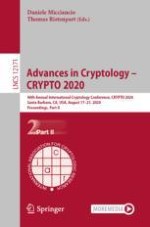2020 | OriginalPaper | Buchkapitel
Random Self-reducibility of Ideal-SVP via Arakelov Random Walks
verfasst von : Koen de Boer, Léo Ducas, Alice Pellet-Mary, Benjamin Wesolowski
Erschienen in: Advances in Cryptology – CRYPTO 2020
Aktivieren Sie unsere intelligente Suche, um passende Fachinhalte oder Patente zu finden.
Wählen Sie Textabschnitte aus um mit Künstlicher Intelligenz passenden Patente zu finden. powered by
Markieren Sie Textabschnitte, um KI-gestützt weitere passende Inhalte zu finden. powered by
